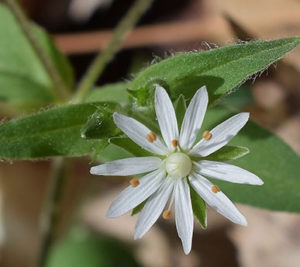
Several species of chickweeds (Stellaria spp.) can be found in Kentucky and the surrounding states. The most common species are common chickweed (S. media) and star chickweed (S. pubera). Common chickweed is an exotic introduced from Europe. It is commonly found in yards and other disturbed locations. In Kentucky, it is considered a severe invasive meaning that it can crowd out other plants growing in the area. Star chickweed, on the other hand, is a native species that is most often found in rocky woods.
Chickweeds are short, herbaceous plants and are often some of the earliest herbaceous plants to bloom in the late winter and early spring. Common chickweed will bloom most in the early spring, but may also bloom in the fall or during cooler periods. Star chickweed blooms almost exclusively in the early spring.
Chickweed flowers are often visited by several species of native bees and pollinating flies. In urban settings, honey bees may also visit common chickweed. Caterpillars of the drab brown wave moth (Lobocleta ossularia) eat chickweed foliage.
At first glance, chickweeds appear to have 10 bright white petals, but look closely and you will see that there are actually only five petals. Each of the petals has a deep cleft down its middle which gives the impression that there are twice as many petals as there really are. The small, bright white flowers against the dark ground can look like little stars. In fact, the genus Stellaria means star.


This article was part of Shannon’s original Kentucky Pollinators and Backyard Wildlife blog which evolved into the blog for Backyard Ecology.

Backyard Ecology: Exploring Nature in Your Backyard
Nature isn’t just “out there.” It’s all around us, including right outside our doors. Hi, my name is Shannon Trimboli, and I am the host of Backyard Ecology. I live in southcentral Kentucky and am a wildlife biologist, educator, author, beekeeper, and owner of a nursery specializing in plants for pollinators and wildlife conservation. I invite you to join me as we ignite our curiosity and natural wonder, explore our yards and communities, and improve our local pollinator and wildlife habitat. Learn more or subscribe to my email list at www.backyardecology.net.

Leave a Reply